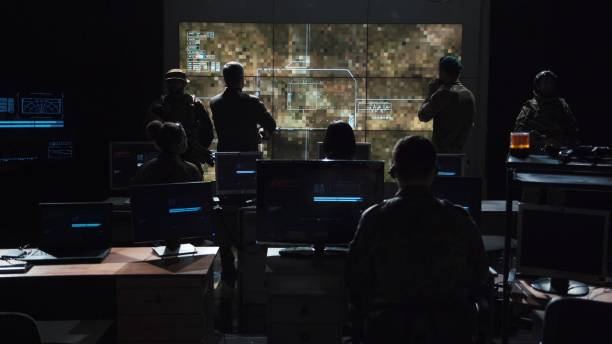In the past century, military strategy has undergone profound changes, shaped by technological advancements and the shifting geopolitical landscape. As we transition further into the digital age, military powers must continuously adapt their strategies to meet new challenges and seize emerging opportunities. From the early use of radar and encryption to modern-day cyber warfare and autonomous systems, the integration of cutting-edge technologies has revolutionized how nations approach defense and security. Understanding the evolution of military strategy is crucial not only for defense experts but for anyone concerned with global security dynamics.
The Dawn of Digital Warfare
The rise of the digital age has fundamentally transformed the battlefield. With the advent of advanced communications systems, satellites, and information technologies, wars are no longer limited to physical battlegrounds. The internet, social media platforms, and sophisticated surveillance systems now play a pivotal role in modern military operations. Countries can deploy cyberattacks to disrupt infrastructure, spread misinformation, or steal sensitive data without ever deploying soldiers. This shift means that military strategy has evolved to prioritize digital dominance, making cyberspace the newest domain of warfare.
A key aspect of this new domain is the ability to gather, process, and analyze vast amounts of data. Intelligence has always been a core element of military planning, but in the digital era, data has become the most valuable asset. Military organizations can use real-time analytics to make informed decisions, predict enemy movements, and optimize battlefield tactics. However, this also brings new vulnerabilities, as reliance on data and networks exposes military operations to hacking and cyber threats.
Cyber Warfare
One of the most significant developments in recent decades is the rise of cyber warfare. Cyberattacks can be as destructive as traditional warfare, targeting essential services like energy grids, water supplies, or even national defense systems. The widespread use of digital technology in both civilian and military spheres has created opportunities for adversaries to exploit weaknesses remotely. Consequently, military strategy now includes robust cybersecurity measures to defend against such attacks, as well as offensive capabilities to launch their own.
Nations are increasingly aware that the next major conflict may not start with boots on the ground but with a sophisticated cyber onslaught aimed at crippling a country’s infrastructure. For instance, during various global conflicts, hackers have taken down financial systems, disrupted communication channels, and even compromised nuclear facilities. This reliance on technology has forced military planners to rethink traditional strategies and incorporate cyber defense as a fundamental pillar of national security.
AI and Autonomous Systems in Modern Military Strategy
The integration of artificial intelligence (AI) and autonomous systems is another significant leap forward in military strategy. AI can process battlefield data faster than any human analyst, providing commanders with actionable insights in real-time. These technologies are increasingly being used for surveillance, reconnaissance, and even combat operations. Autonomous drones, for example, can carry out missions with minimal human intervention, changing the dynamics of air, land, and sea warfare.
However, this evolution presents ethical and strategic dilemmas. Can machines be trusted to make life-and-death decisions? How do military leaders ensure accountability when autonomous systems go wrong? These are critical questions as the digital age reshapes military strategy, emphasizing both the promise and perils of integrating AI into military operations.
As these technologies become more advanced, the role of human soldiers may shift from direct combat to overseeing and managing autonomous systems. This evolution suggests a future where wars could be fought remotely, with minimal human casualties on the battlefield. However, the strategic challenge lies in maintaining control over these systems, ensuring they function within the desired parameters, and preventing adversaries from hijacking or disabling them.
Role of Information Warfare
Beyond cyberattacks and autonomous systems, military strategy in the digital age increasingly emphasizes information warfare. The ability to control the narrative, shape public perception, and manipulate information can be just as powerful as military force. Governments and military organizations now recognize that winning hearts and minds is critical to achieving strategic objectives.
In recent conflicts, we have seen how social media and other digital platforms have been weaponized to influence public opinion, spread propaganda, and even incite violence. Information warfare is not just about disinformation; it includes psychological operations, media manipulation, and the strategic use of digital tools to undermine an adversary’s credibility. As such, military strategy must include a strong emphasis on information dominance and the protection of digital assets.
Integrating Conventional and Digital Warfare
While the digital age has introduced new forms of conflict, conventional military forces remain an essential part of any strategic plan. Air, land, and sea forces still play a crucial role in defending national interests and projecting power. However, the key to success in modern warfare is integrating these traditional capabilities with the latest technological advancements.
This is where Zachary S Novel Above Scorched Skies offers a unique exploration of the future of warfare. In his novel, the intertwining of advanced technologies and military strategy is central to the plot, providing readers with a vivid illustration of the complexities that lie ahead. The story delves into the challenges faced by global powers as they navigate a rapidly changing world where AI, cyber warfare, and information dominance reshape the very nature of conflict.
Summary
The digital age has introduced unprecedented changes to military strategy, forcing nations to rethink how they prepare for and engage in conflicts. From cyber warfare to AI and autonomous systems, the future battlefield will be a blend of traditional and digital elements. To remain competitive, military forces must continue to evolve, integrating cutting-edge technologies while addressing the ethical, legal, and strategic challenges that come with them.
As the global security environment continues to shift, the role of technology in warfare will only grow more pronounced. Understanding the evolution of military strategy in this context is critical not only for military professionals but for policymakers, academics, and the public. The key to future success lies in balancing technological innovation with the time-tested principles of military planning, ensuring that nations remain prepared for both the challenges and opportunities that lie ahead.




